Crossing the mighty Peace River on Alberta’s longest – and most yellow! – suspension bridge we looked over and saw our destination, Dunvegan. From fort to mission to trading post to provincial and national historic site, it has a long and storied past. Historic Dunvegan has been on our radar for years, but it took a trip to the Yukon and a wedding in Saskatchewan to turn this wish list Alberta heritage site visit into reality.
Disclosure: This post contains Affiliate links.
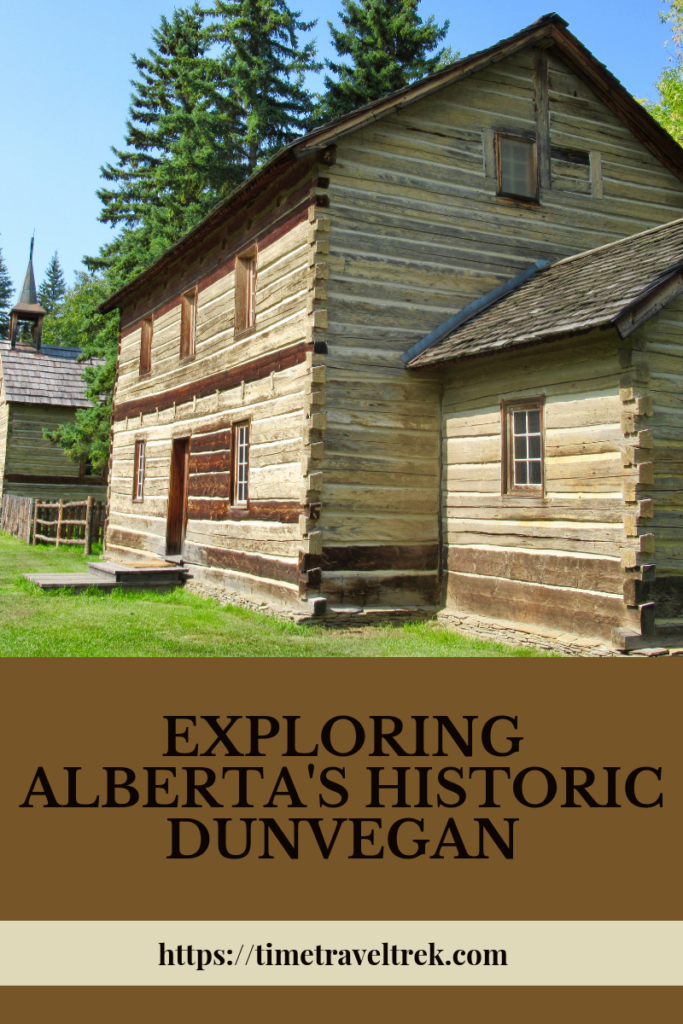
Table of Contents
Detouring for Dunvegan
We rolled into the historic site on a brilliant summer’s day – grass green, trees in shade-filled leaf, birds singing.
Our timing could not have been more perfect, even if unplanned.
Truth be told, we were beelining straight from adventures in the Yukon to a family friend’s wedding in Battlefords Provincial Park.
When we saw that Dunvegan was a short distance north of our route, we couldn’t resist a detour to spend an afternoon soaking up the historical essence of one of Alberta’s cornerstones.
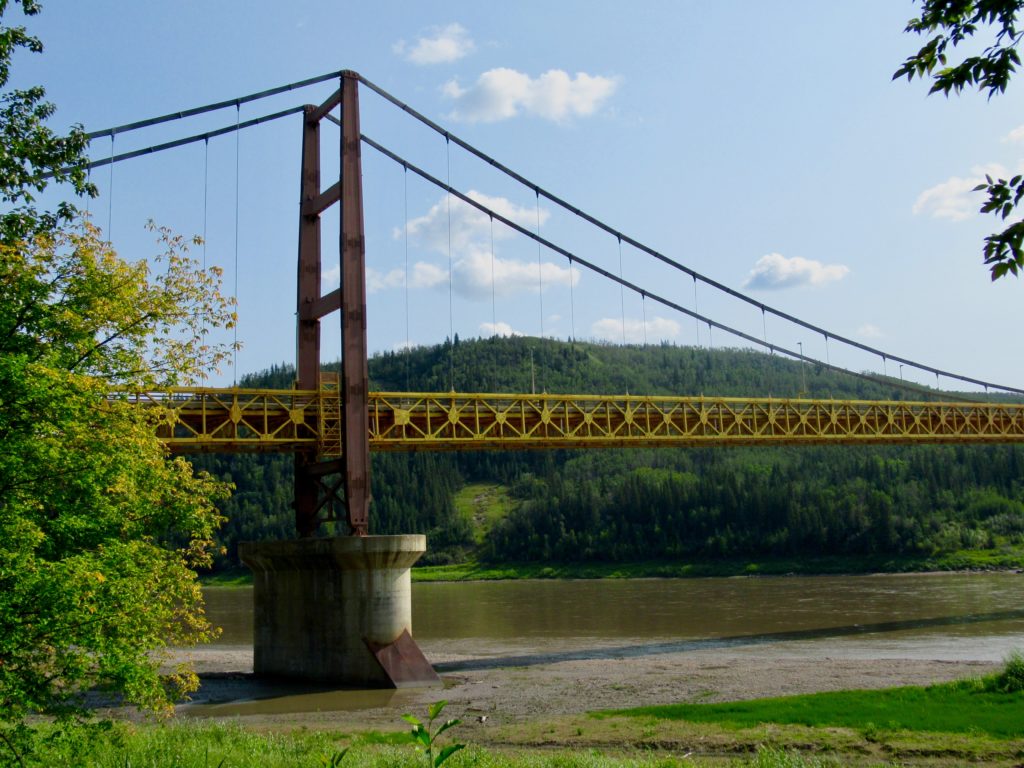
Time out for Some Adventurous History
In the spring of 1793, explorer Alexander Mackenzie and his crew of five voyageurs launched their canoes, leaving their winter camp near today’s town of Peace River.
It was Mackenzie’s second attempt to reach the Pacific Ocean – the first trip saw him paddling north to the Arctic Ocean on what is now called the Mackenzie River.
The scope of his journeys compared to our miniscule paddling adventures boggles my mind. Mackenzie was the first European to cross North America – more than 10 years before anyone on the Lewis and Clark expedition even lifted a paddle!
What Has All Of This Got To Do With Dunvegan?
After passing the most southerly bend of the Peace River, in what today is the province of Alberta, Mackenzie made note of the wealth of wildlife in the area in his journal.
Twelve years later, Archibald McLeod paddled the Peace River in search of the perfect location to build a fur trading post on behalf of the North West Company (NWC).
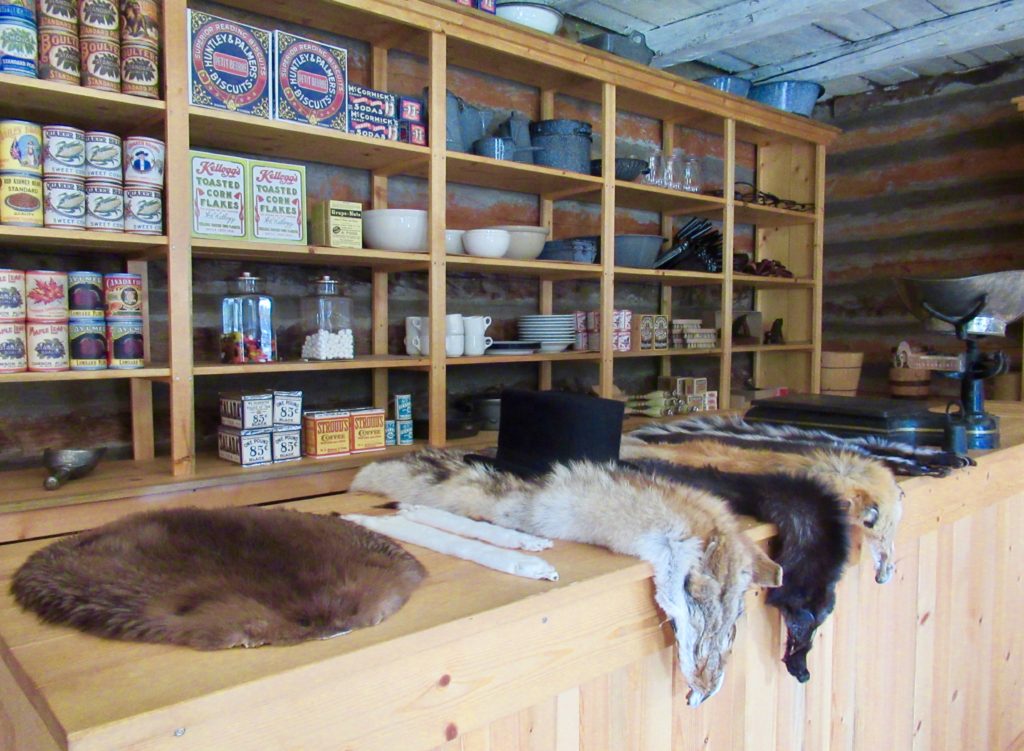
He knew that this area was a gathering place for the Dunne-za (Beaver) people and he remembered Mackenzie’s comments about the abundance of wildlife.
MacLeod chose the largest flat bench on the north bank on the same southerly bend of the Peace River for the site of Fort Dunvegan.
It was named for MacLeod’s home on Scotland’s Isle of Skye.
The Fur Trade
The Northwest Company was headquartered in Montreal. It was a complex 3000-mile (more than 4800 kilometre) river and portage journey from Montreal to Dunvegan in 1805. The voyage took months to complete, but trade was brisk.
In fact, trade was so good that the rival Hudson’s Bay Company took note. Between 1805 and 1821, the two companies became locked in a battle for control of the fur trade along the Peace River.
It ended in a merger of the two companies under the name of Hudson’s Bay Company (HBC).
Fort Dunvegan was in a prime location for fur trade. Its fertile flats also grew bountiful crops and food resources that fed Dunvegan staff and other posts as well. Dunvegan would eventually become headquarters for the Athabasca district.
In 1879, new buildings were constructed near the original fort site, including a residence for the Factor, or manager, of the new post.
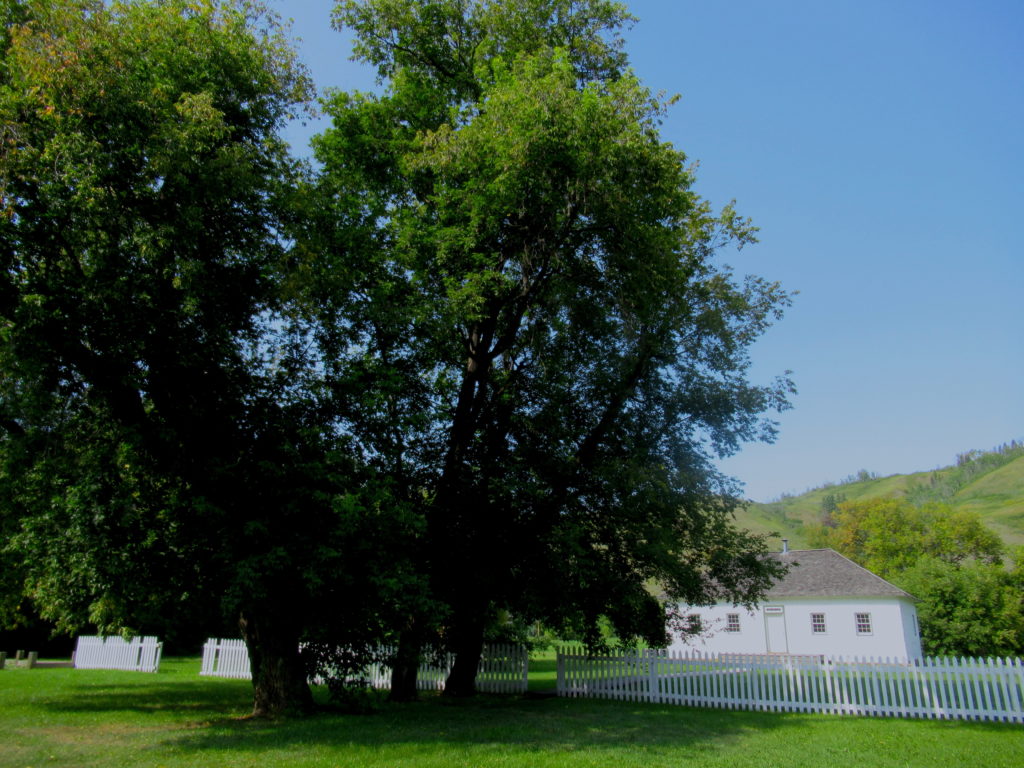
On a Mission
Fur trading posts were often associated with religious missions and Dunvegan was no different.
In 1867, Father Christophe Tissier, a Catholic Oblate missionary, became the first resident priest.
Father Tissier was as tough as he was devout.
He didn’t know how to communicate well with the Denne-za, but he didn’t give up.
He didn’t fit in with the fur traders, but that didn’t turn him away.
His living conditions were… well… hard, but that was mostly his choice. Father Tissier’s nights were spent sleeping on a buffalo robe on the floor, using the next morning’s firewood under his head for a pillow.
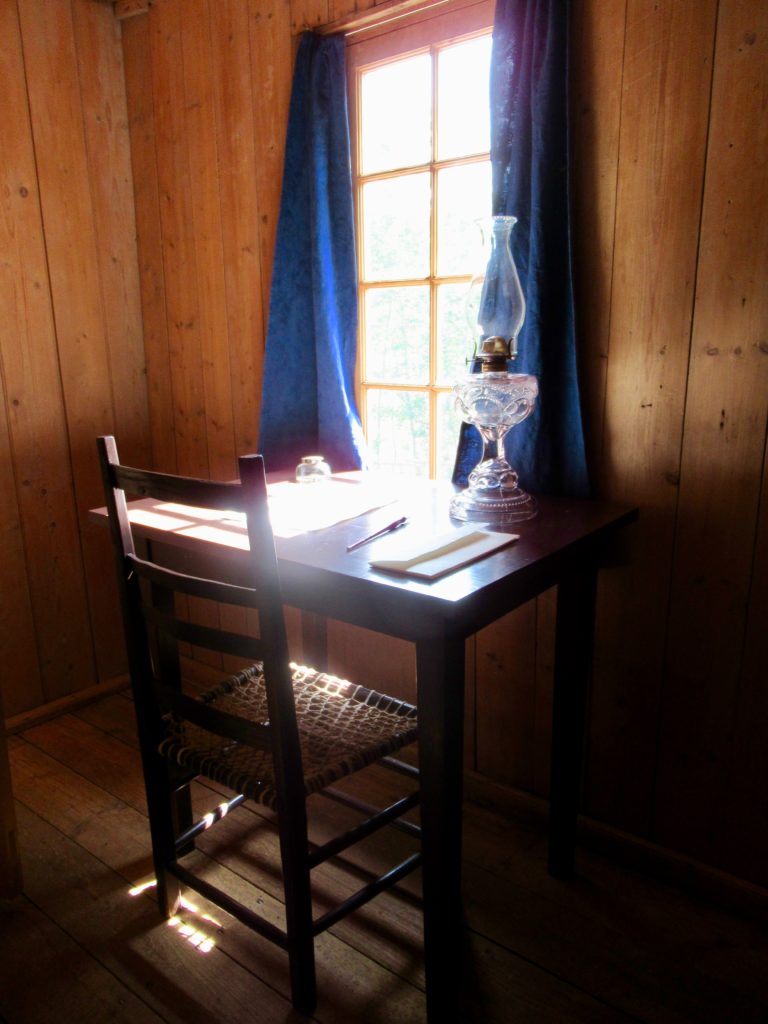
Life got a little bit easier when Father August Husson arrived in 1881. Together, both men began work on an addition to the original house-chapel.
Father Emile Grouard became the Superior of the St. Charles Mission for three years starting in 1883. He was instrumental in stressing that the priests learn to communicate with the Dunne-Za, or Beaver Indian First Nation, in their own language.
Construction of the church began in 1885, followed a couple of years later by a rectory.
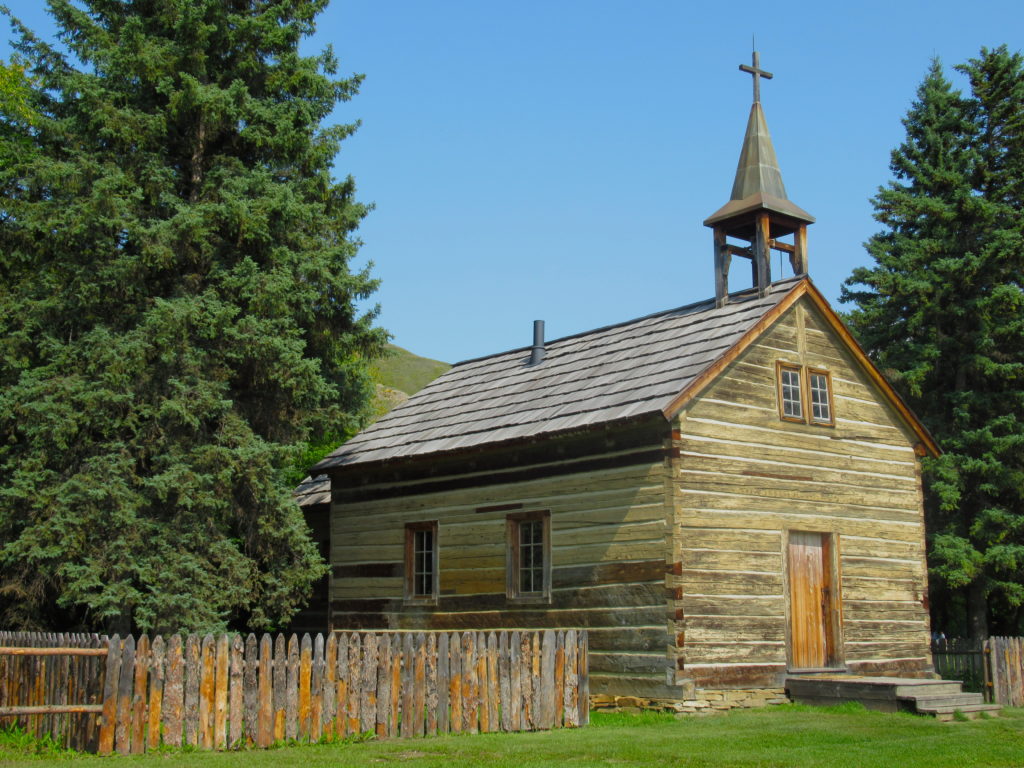
Going, Going, Gone
At the same time as the mission was building up, fur trading was slowly going down. Bison were rapidly disappearing. New trade routes were shifting the focus away from the Peace River region. Local Dunne-za populations began dwindling in numbers.
In 1903, the St. Charles Mission closed.
The church became a grain storage facility, a family home, a bunkhouse for travellers crossing the Peace River, a gas station and even a tire repair shop before becoming property of the Province of Alberta in 1956.
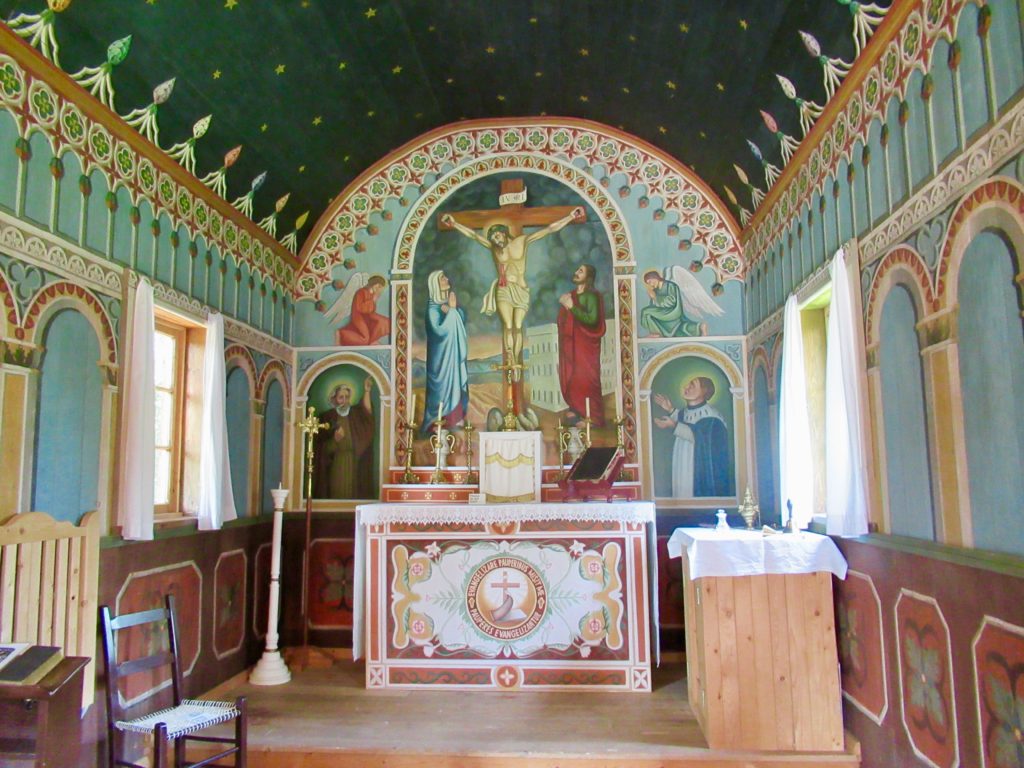
Staff of the Dunvegan ferry (established in 1909) used the rectory as a residence. One of the ferry operators turned part of the main floor into a general store in the 1920s and 1930s. The building was abandoned after 1940.
Gradually switching its focus from trading furs to more of a commercial operation, the HBC considered closing Fort Dunvegan in the 1890s. Clerk Albert Tate and his significantly smaller staff of four continued operations until 1918.
Of Ghosts and Footprints
Today’s visitors are guided by heritage interpreters past footprints of old HBC warehouses and storerooms on the Fur Trade Tour before entering the pristine, white-washed 1879 factor’s house.
Stepping into the oldest building in Alberta north of St. Albert is a history buff’s dream. Finding it refurbished with priceless period and replica artifacts is a boon. Finishing the picture-perfect window to the past is a complete original – Albert Tate’s desk. One can almost visualize him sitting in the front room, completing his work for the day.
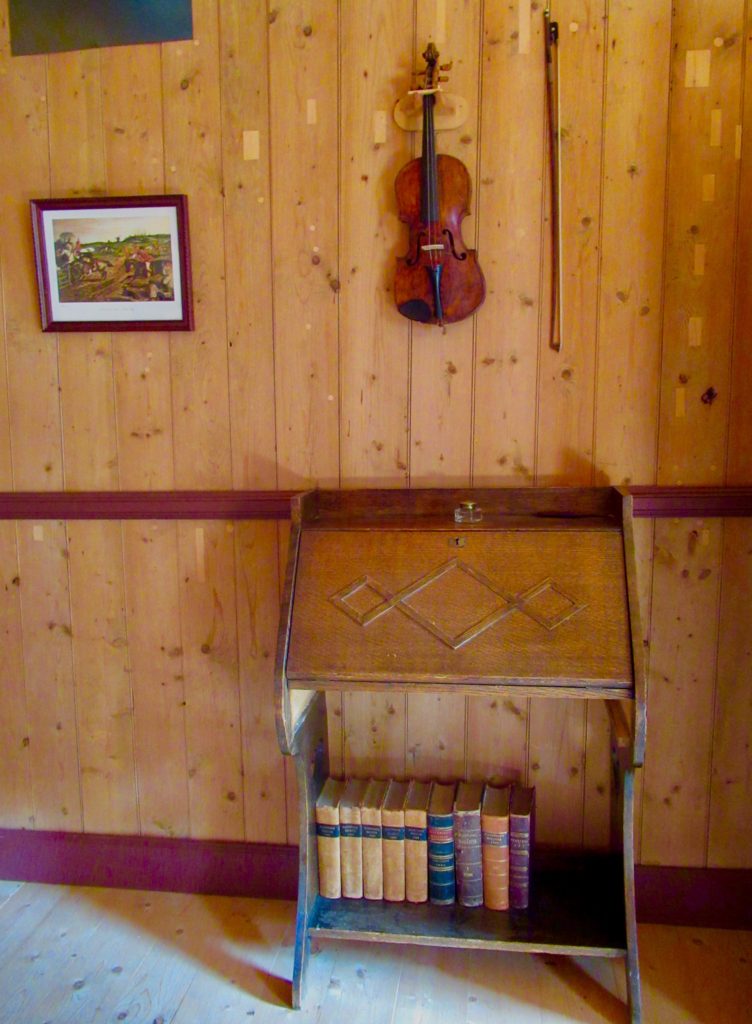
Over at the rectory, it’s not hard to see where the priests knelt on the wooden floor of the rectory chapel. A small dent in the floor is a testament to their faith. On the wall above, a lighter colour in the paint marks a ghost image, where a painting once hung.
Remarkably, 70% of the rectory is original wood. Next door, an amazing 95% of the church is original. Inside the church, Father Grouard’s paintings have been faithfully restored to their singular glory. Excuse us while we pull up a pew to sit a while and soak it all in.
Dunvegan – it’s a cornerstone of Alberta’s heritage well worth a detour.

When You Go
Historic Dunvegan is located 26 kilometres south of Fairview, Alberta on Highway 2. Details on current hours and admission fees can be found here.
Learn more about Alberta’s history in these posts:
- Discovering Alberta’s Grande Cache
- Discovering Alberta’s History: On a Mission
- Lille Ghost Town
- Exploring Head-Smashed-In Buffalo Jump
- Exploring the Crowsnest Pass: Hillcrest Mine Disaster Memorial Park
- A Journey Close to Home: Walking Glenbow Ranch


Very interesting!
Thanks Chris – so many cool historic sites to explore! Cheers, Megan
A stop I’ve never made…but I will!
You’ll enjoy it Karen. Cool list of historic Sites and museums in Alberta at https://www.alberta.ca/historic-sites-museums.aspx (Dunvegan included). A $50 annual pass gets you into all of the sites with entrance fees – would be fun to map it out and do in one trip!
How do I become a period actor here?
Check the Historic Dunvegan website for employment opportunities; good luck!